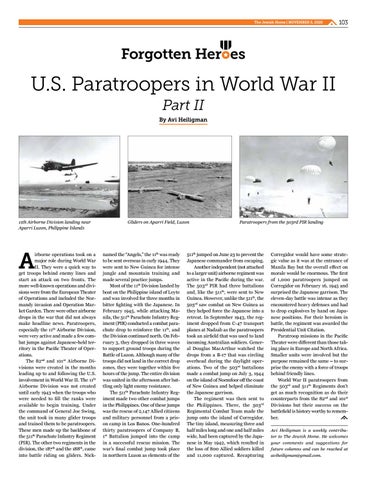The Jewish Home | NOVEMBER 5, 2020
32
103
OCTOBER 29, 2015 | The Jewish Home
Forgotten Her es
U.S. Paratroopers in World War II Part II By Avi Heiligman
11th Airborne Division landing near Aparri Luzon, Philippine Islands
A
irborne operations took on a major role during World War II. They were a quick way to get troops behind enemy lines and start an attack on two fronts. The more well-known operations and divisions were from the European Theater of Operations and included the Normandy invasion and Operation Market Garden. There were other airborne drops in the war that did not always make headline news. Paratroopers, especially the 11th Airborne Division, were very active and made a few combat jumps against Japanese-held territory in the Pacific Theater of Operations. The 82nd and 101st Airborne Divisions were created in the months leading up to and following the U.S. involvement in World War II. The 11th Airborne Division was not created until early 1943 when the troops who were needed to fill the ranks were available to begin training. Under the command of General Joe Swing, the unit took in many glider troops and trained them to be paratroopers. These men made up the backbone of the 511th Parachute Infantry Regiment (PIR). The other two regiments in the division, the 187 th and the 188th, came into battle riding on gliders. Nick-
Gliders on Aparri Field, Luzon
named the “Angels,” the 11th was ready to be sent overseas in early 1944. They were sent to New Guinea for intense jungle and mountain training and made several practice jumps. Most of the 11th Division landed by boat on the Philippine island of Leyte and was involved for three months in bitter fighting with the Japanese. In February 1945, while attacking Manila, the 511th Parachute Infantry Regiment (PIR) conducted a combat parachute drop to reinforce the 11th, and the Division continued north. On February 3, they dropped in three waves to support ground troops during the Battle of Luzon. Although many of the troops did not land in the correct drop zones, they were together within five hours of the jump. The entire division was united in the afternoon after battling only light enemy resistance. The 511th Parachute Infantry Regiment made two other combat jumps in the Philippines. One of these jumps was the rescue of 2,147 Allied citizens and military personnel from a prison camp in Los Banos. One-hundred thirty paratroopers of Company B, 1st Battalion jumped into the camp in a successful rescue mission. The war’s final combat jump took place in northern Luzon as elements of the
Paratroopers from the 503rd PIR landing
511th jumped on June 23 to prevent the Japanese commander from escaping. Another independent (not attached to a larger unit) airborne regiment was active in the Pacific during the war. The 503rd PIR had three battalions and, like the 511th, were sent to New Guinea. However, unlike the 511th, the 503rd saw combat on New Guinea as they helped force the Japanese into a retreat. In September 1943, the regiment dropped from C-47 transport planes at Nadzab as the paratroopers took an airfield that was used to land incoming Australian soldiers. General Douglas MacArthur watched the drops from a B-17 that was circling overhead during the daylight operations. Two of the 503rd battalions made a combat jump on July 3, 1944 on the island of Noemfoor off the coast of New Guinea and helped eliminate the Japanese garrison. The regiment was then sent to the Philippines. There, the 503 rd Regimental Combat Team made the jump onto the island of Corregidor. The tiny island, measuring three and half miles long and one and half miles wide, had been captured by the Japanese in May 1942, which resulted in the loss of 800 Allied soldiers killed and 11,000 captured. Recapturing
Corregidor would have some strategic value as it was at the entrance of Manila Bay but the overall effect on morale would be enormous. The first of 1,000 paratroopers jumped on Corregidor on February 16, 1945 and surprised the Japanese garrison. The eleven-day battle was intense as they encountered heavy defenses and had to drop explosives by hand on Japanese positions. For their heroism in battle, the regiment was awarded the Presidential Unit Citation. Paratroop missions in the Pacific Theater were different than those taking place in Europe and North Africa. Smaller units were involved but the purpose remained the same – to surprise the enemy with a force of troops behind friendly lines. World War II paratroopers from the 503rd and 511th Regiments don’t get as much recognition as do their counterparts from the 82nd and 101st Divisions but their success on the battlefield is history worthy to remember. Avi Heiligman is a weekly contributor to The Jewish Home. He welcomes your comments and suggestions for future columns and can be reached at aviheiligman@gmail.com.
























